Raj Ghat and associated memorials
Raj Ghat is a memorial dedicated to Mahatma Gandhi in Delhi, India. Originally it was the name of a historic ghat of Old Delhi (Shahjahanabad). Close to it, and east of Daryaganj was Raj Ghat Gate of the walled city, opening at Raj Ghat to the west bank of the Yamuna River.[1][2] Later the memorial area was also called Raj Ghat. It is a black marble platform that marks the spot of Mahatma Gandhi's cremation, Antyeshti (last rites) on 31 January 1948, a day after his assassination. It is left open to the sky while an eternal flame burns at one end. Located on Delhi's Ring Road, officially known as Mahatma Gandhi Road, a stone footpath flanked by lawns leads to the walled enclosure that houses the memorial.
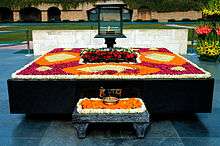
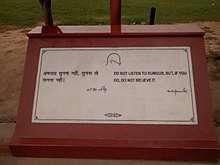

Other memorials in the Raj Ghat area
Raj Ghat loosely translates to Royal Steps (with "royal" alluding to the importance of the place and "steps" referencing the bank of Yamuna River).[3] Several other samadhis or cremation spots of other famous leaders can be found in the vicinity of Raj Ghat. The landscaping and planting of these memorials was performed by Alick Percy-Lancaster, the last Englishman to hold the post of Superintendent of Horticultural Operations, Government of India.
Jawaharlal Nehru's samadhi is to the north of the Raj Ghat and is known as the Shantivan meaning the "garden of peace". Adjacent to Nehru's memorial is Ekta Sthal, the site where Zail Singh, 7th President of India, was cremated with full state honours in 2005.
The Raj Ghat area has a park adorned with trees planted by visiting dignitaries and heads of state.
| Name | Title | Year of death | Memorial name | Meaning | Area (acres)[4] |
Feature |
|---|---|---|---|---|---|---|
| Mahatma Gandhi | Father of the Nation | 1948 | Raj Ghat | Royal Platform | 5.1 | Blue marble platform |
| Jawaharlal Nehru | Prime Minister of India | 1964 | Shantivan | Garden of Peace | 52.6 | A large plinth covered with a lawn |
| Lal Bahadur Shastri | Prime Minister of India | 1966 | Vijay Ghat | Victory Platform | 40 | The victory alluded to in the name of the memorial is India's performance under his leadership in the Indo-Pakistani War of 1965. |
| Indira Gandhi | Prime Minister of India | 1984 | Shakti Sthal | Place of Strength | 45 | A huge greyish-red monolithic stone |
| Jagjivan Ram | Deputy Prime Minister of India | 1986 | Samta Sthal | Place of Equality | 12.5 | — |
| Charan Singh | Prime Minister of India | 1987 | Kisan Ghat | Farmer's Platform | 19 | — |
| Rajiv Gandhi | Prime Minister of India | 1991 | Veer Bhumi | Land of Brave | 15 | A large lotus in full bloom carved out of stone surrounded by 46 small lotuses to signify the years he lived; rocks from all the states of India are spread around.[5] |
| Zail Singh | President of India | 1994 | Ekta Sthal | Place of Unity | 22.56 | — |
| Morarji Desai | Prime Minister of India | 1995 | [6] [7] | |||
| Shankar Dayal Sharma[8] | President of India | 1999 | Karma Bhumi | Land of Duty | Located near Vijay Ghat. | |
| Devi Lal | Deputy Prime Minister of India | 2001 | Sangharsh Sthal | Place of Struggle | Located near Kisan Ghat. | |
| Chandra Shekhar | Prime Minister of India | 2007 | Jannayak Sthal[9] | Place of People's Leader | — | |
| Inder Kumar Gujral | Prime Minister of India | 2012 | Smriti Sthal | Place of Remembrance | — | |
| Atal Bihari Vajpayee | Prime Minister of India | 2018 | Sadaiv Atal | Immortal Forever | Located near Vijay Ghat and Raj Ghat, New Delhi |
Gallery
- Pictures of memorials near Raj Ghat
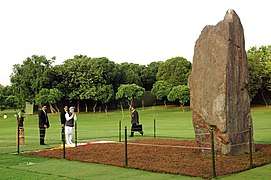 Manmohan Singh at Shakti Sthal, 15 August 2007
Manmohan Singh at Shakti Sthal, 15 August 2007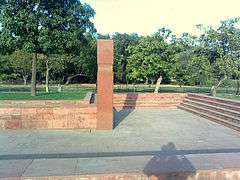 Sanjay Gandhi Memorial, Delhi
Sanjay Gandhi Memorial, Delhi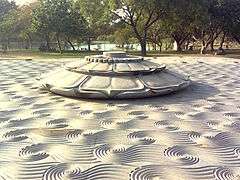 Veer Bhumi
Veer Bhumi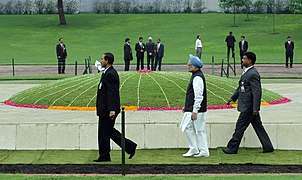 Manmohan Singh at Shantivan, 15 August 2008
Manmohan Singh at Shantivan, 15 August 2008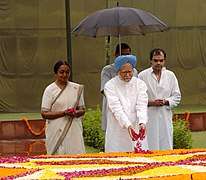 Manmohan Singh at Samta Sthal, 5 April 2008
Manmohan Singh at Samta Sthal, 5 April 2008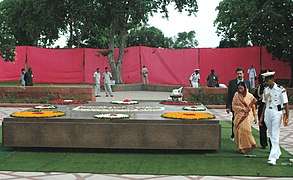 Pratibha Patil at Vijay Ghat, 26 July 2007
Pratibha Patil at Vijay Ghat, 26 July 2007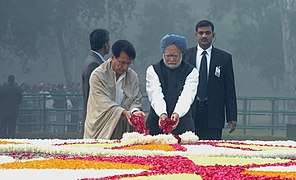 Manmohan Singh at Kisan Ghat, 23 December 2006
Manmohan Singh at Kisan Ghat, 23 December 2006
References
- Fanshawe, p. 67
- 1863 Atlas Map of Delhi
- Maddipati, Venugopal. "When Landscape Became King: A Short Note on the Ascendancy of the Immediate Present as the Sovereign of Rajghat". LA Journal of Landscape Architecture, India. Retrieved 27 January 2020.
- "No space for 'samadhis', VVIPs to share memorial place in Delhi". Rediff.com. 16 May 2013. Retrieved 30 November 2013.
- "'Rajiv' to bloom at Veer Bhumi". The Tribune Trust. 18 August 2004. Retrieved 21 December 2008.
- https://apnews.com/1eb7f10955d9e3844c0ee1a8cb892cdf
- https://www.indiatoday.in/education-today/gk-current-affairs/story/crematoriums-and-samadhi-sthals-or-memorials-of-famous-people-in-india-and-the-world-1580118-2019-08-12
- "Tearful farewell to S.D. Sharma". The Tribune. The Tribune Trust. 28 December 1999. Retrieved 21 December 2008.
- "Former PM Chandrashekhar's samadhi to be called Jannayak Sthal". The Times of India. 23 April 2015. Retrieved 19 November 2015.
- H.C. Fanshawe (1998). Delhi, past and present. Asian Educational Services. ISBN 81-206-1318-X.